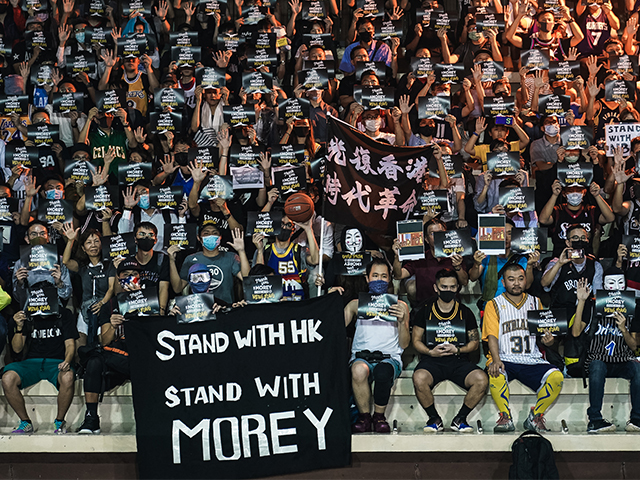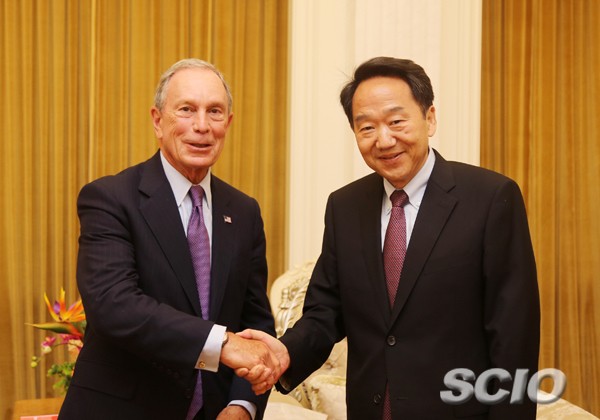BuzzFeed founder Ben Smith’s announcement last week that his Semafor “global news platform” would be partners with a Chinese Communist Party think tank is just the latest example of Beijing’s relentless attempts to gain influence over U.S. media.
China has invested a great deal of money and effort in shaping American news content, although most of its past efforts were a bit more subtle than Semafor’s openly-declared symbiosis.

Ben Smith, editor-in-chief of BuzzFeed News, hands out free copies of a BuzzFeed News newspaper outside the Union Square subway station, March 6, 2019 in New York City. (Drew Angerer/Getty Images)
Breitbart News Editor-in-Chief Alex Marlow extensively covered China’s efforts to purchase U.S. media influence in his best-selling book Breaking the News: Exposing the Establishment Media’s Hidden Deals and Secret Corruption.
The New York Times, Washington Post, L.A. Times, Seattle Times, Houston Chronicle, Chicago Tribune, Boston Globe, Foreign Policy, and Wall Street Journal have all been paid millions of dollars to run Chinese “advertorials,” which are essentially propaganda dressed up to look like op-eds with small disclaimers that the papers were paid to publish the material. Marlow noted that some of these same papers have suffered newsroom revolts over running op-eds written by American conservatives.
China does not always have to fork over cash to get the editorial space it craves. Chinese Communist Party apparatchiks frequently pen opinion pieces for American and European papers, exploiting a spirit of “openness” to “divergent opinions” that China would never be foolish enough to grant foreigners with its own state media.
Marlow cited the example of blatant propaganda from a pro-Beijing politician in Hong Kong that was cheerfully published by the New York Times, even though it was an apologia for the authoritarian “national security law” China imposed on Hong Kong over the fierce opposition of human rights groups around the world — groups whose input left-wing newspapers would normally treat as very important when making editorial decisions.
Marlow pointed out that China uses its economic leverage over American media corporations to influence coverage, a practice known as “sharp power” that was on particularly obnoxious display when Beijing went to war against Houston Rockets manager Daryl Morey for supporting pro-democracy protesters in Hong Kong. Chinese state media openly boasted that China’s enormous financial influence over the National Basketball Association (NBA) prodded the NBA to take action against Morey, who eventually lost his job with the Houston Rockets.

Hundreds of basketball fans gather in Wan Chai Southorn Playground to show support of the Houston Rockets general manager Daryl Morey on October 15, 2019, in Hong Kong (Lampson Yip/Getty Images)
Beijing is not shy about letting foreign media organizations, and their major U.S. partners, know that lucrative contracts in China could be imperiled by running content that displeases the Chinese Communist Party. China’s nauseating influence over Hollywood content is the stuff of legend, and some of those entertainment corporations own news outlets.
Marlow devoted an entire chapter of Breaking the News to China’s uncomfortably close relationship with former New York City mayor and presidential candidate Michael Bloomberg’s media empire. Marlow’s research found Chinese Communist Party officials discussing much the same type of influencer partnership with Bloomberg that Smith would later announce openly for Semafor.
Besides using “sharp power” to threaten foreign media organizations with bans and censorship if they do not toe the Chinese Communist Party line, China also influences the media by keeping a tight grip on information flowing from China.
The International Federation of Journalists (IFJ) warned in May 2021 that China exploited the coronavirus pandemic to greatly increase its influence over worldwide media. Beijing’s efforts were aided by the pandemic hammering advertising revenue for foreign media outlets, which made them more dependent than ever on “news” content produced and packaged in China. The pandemic also gave China an excuse to kick more foreign reporters out of the country, eliminating the competition for content generated by Communist Party media operations.
IFJ said the Wuhan coronavirus emergency triggered the “activation of the existing media infrastructure China has put in place globally, which includes training programs and sponsored trips for global journalists, content sharing agreements feeding state-sponsored messages into the global news ecosystems, memoranda of understanding with global journalism unions, and increasing ownership of publishing platforms.”
The result was that China ended up with “more positive global coverage of its actions and policies than pre-pandemic.”
One of the biggest dangers highlighted by the IFJ report was that Western reporters have a vastly exaggerated sense of their own immunity to manipulation by state propaganda operations. Whether this was hubris from Western reporters who regard themselves as an Information Age clergy that is uniquely equipped to spot disinformation, or simply a fairy tale journalists told themselves to get through the night because they could do nothing about China’s enormous financial sway over their employers, is open to debate.
Dictator Xi Jinping is very enthusiastic about using Chinese influence networks to shape Western opinion, especially the “United Front” system, a vast network of Chinese Communist operations that disguise themselves as everything from diplomatic and cultural outreach programs to charities.
Perhaps the most notorious appendage of the United Front was the Confucius Institute, a system of educational resources provided to American universities that masqueraded as innocuous “free” instruction in Chinese language and culture, but was actually a method of spreading propaganda and keeping the Chinese diaspora in line. The universities that journalists matriculate from are targets for United Front influence.
China spent about $6.6 billion over the past decade to strengthen its media influence operations, and it shows no sign of slowing down. In 2020, China began exploring how it could use its “Belt and Road News Network,” an adjunct of its massive Belt and Road infrastructure program, to assert editorial control over all global media. The idea was to let Belt and Road client states know that China expected a powerful role in “gatekeeping” their news to exclude “racist” content.
China has one other powerful tool for influencing American media: social media, especially Twitter, which is beloved of journalists. Chinese citizens are banned from using Twitter, and Beijing would never dream of allowing foreign Internet users – let alone foreign government operatives – to use China’s heavily censored social media platforms to influence the public. And yet, Chinese officials have Twitter accounts, and use them aggressively to spread government propaganda.
As long as China sees media influence as completely asymmetrical – with Beijing free to use money and various forms of leverage to sculpt American media coverage, while the outside world is completely blocked from influencing Chinese media – it will be happy to invest vast amounts of money and manpower in the rigged game.


COMMENTS
Please let us know if you're having issues with commenting.